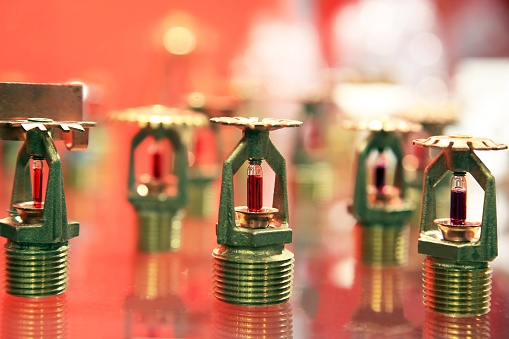
Fire sprinkler systems are known for their longevity. Some systems may even be as old as the building in which they are installed. If the system is that old, it also means some of the parts may be just as old. Sprinklers, commonly referred to as “sprinkler heads”, need to be inspected annually and tested on a 5, 10, 20 or 50-year basis depending on the sprinkler type and their environment.
There are a few different reasons that sprinklers need to be replaced, most of which can be visually identified:
- Loaded Sprinkler
A loaded sprinkler is a sprinkler that is covered in dust, dirt, debris, or grease that is difficult to remove without touching the sprinkler. It can be difficult to clean a sprinkler without accidentally activating it. If cleaning the fire sprinkler requires wiping or scrubbing with a cleaning solution, then the sprinkler needs to be replaced.
- Painted Sprinkler
Never paint sprinklers or cover plates. If a fire sprinkler has been painted, it needs to be replaced. A painted sprinkler can be compromised, which may cause the sprinkler to malfunction.
- Leaks, Rust, Corrosion, Damage
Any sight of leaking water is an issue that needs to be addressed immediately. The sprinkler could be leaking due to damaged or defective equipment, tight fittings, improper installation, or lack of maintenance services. Corrosion is common when dealing with water. If the corrosion is ignored, it could lead to even bigger problems, such as holes in the sprinkler system pipes. The best way to identify corrosion is if there is a rotten egg smell, signs of rust, or the water is coming out discolored. Damage to a sprinkler (or pipe) could have been caused by renovation or construction, vandalism, or even just normal wear and tear. If the sprinkler is in an area that could be susceptible to damages, it’s best to install a protective cage around the sprinkler.
- Plunge Test Failure
A plunge test is done on a sprinkler based on the installation date, or the manufacture date if the installation date is unknown. These tests are done periodically depending on the specific type of sprinklers that have been installed. The test should be completed on a random sample of sprinklers (different floors, rooms, etc.) to be sure different environments in the facility are represented. During the test, each sprinkler is placed in a plunge oven where they are subjected to a defined temperature and velocity that is similar to a fire. The time it takes for the sprinklers to activate are notated. If any fire sprinkler fails to activate in the appropriate amount of time, all sprinklers within the system should be replaced.
Be Safe – Have an Expert Assess Your Sprinklers
If you find any signs of an issue with your sprinklers or your fire sprinkler system, it is best to call a fire sprinkler system professional, like Koorsen Fire & Security, right away. They can conduct an inspection and indicate whether you’re in need of a repair or replacement of any kind.
Koorsen Fire & Security has been in business for over 70 years. Our factory-trained and certified technicians install and maintain fire sprinkler systems and can assist you with all of your inspection and maintenance needs. If you are uncertain whether your sprinklers need to be replaced, give Koorsen Fire & Security a call. We will send one of our highly trained technicians to assess your sprinklers and answer any questions you may have.


